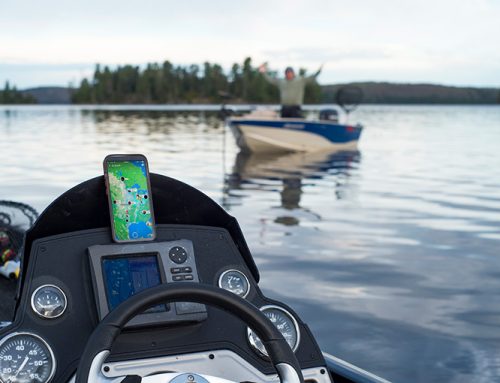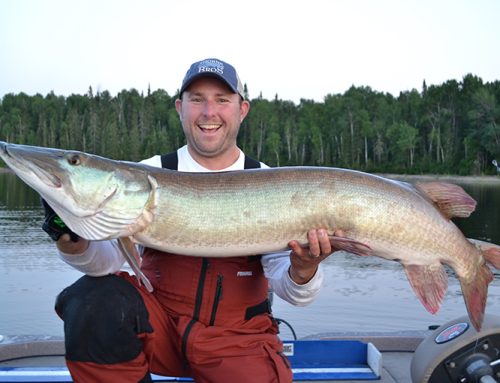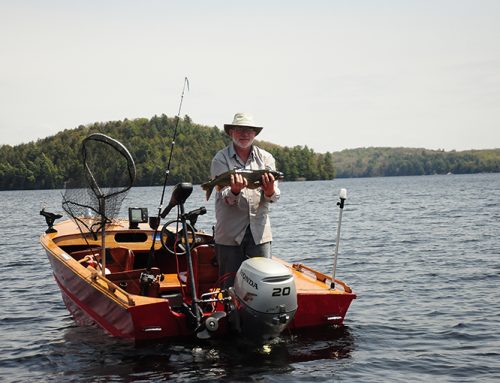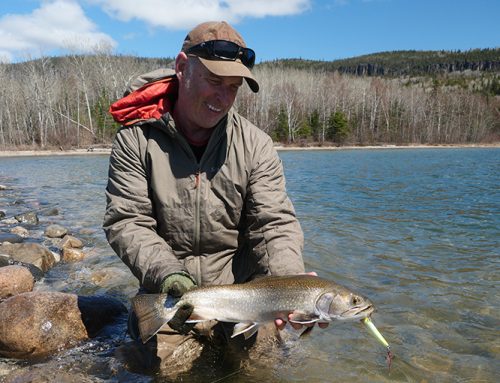
While reviewing the hot threads on a local chat board, I was drawn to a series of photos of an angler hoisting a pair of brilliantly coloured trout. It was a real attention grabber. Their red bellies and white-accented fins clearly differentiated them from any rainbow, brown, or lake trout, and considering their size at well over 10 pounds, there was little chance of them being brook trout. Other anglers weighed in with their congratulatory posts and there was plenty of discussion surrounding species identification, with the consensus eventually being splake.
Even experienced anglers often need to take a second look to accurately identify splake, being that it’s a hybrid between a female lake trout and male brook trout, and take on the colouration and features of both species.
Splake Identification
Splake are notoriously difficult to identify. Look for faint blue halos surrounding pinkish dots along the sides of the fish. Lake trout have no red or blue on their sides. Relative to a brook trout, the dots and blue halos are much fainter. Splake also have a forked tail, unlike the square tail of a brook trout. In the fall, mature splake will take on a reddish colour, which also helps to differentiate them from a lake trout.
Counting pyloric caeca is another technique which can help. Pyloric caeca are finger-like projections found at the intersection of the stomach and the intestines. Brook trout, splake, and lake trout tend to have caeca counts of 23 to 55, 65 to 85, and more than 93, respectively.
With experience, you’ll recognize that brook trout and splake heads are shaped quite differently, but this is a hard feature to confirm without an actual side-by-side comparison. Splake also tend to have lake-trout like dots on their cheeks, unlike brook trout.
Background origins
Splake were initially stocked in Ontario to provide recreational fishing opportunities in inland waters where plantings of brook trout and lake trout had been relatively unsuccessful.
There was also extensive stocking in Lake Huron to reintroduce a deepwater predator following the decline of native lake trout populations. The Georgian Bay experiment failed because the fish were not able to reproduce. Splake stocking continues to this day, often used as a Ministry of Natural Resources (MNR) management tool to divert fishing pressure from native lake trout and brook trout populations, and to provide winter-fishing opportunities where ice fishing for native trout species is not permitted.
The fact that splake can live between 16 to 20 years also makes them a good candidate for put-grow-and-take lakes, in place of brook trout that seldom live longer than 5 years in the wild.
With such a long lifespan, it’s not surprising that splake can grow quite large. The current Ontario record was caught in 1987 in Georgian Bay by Paul Thompson and weighed an impressive 20 pounds, 11 ounces.
Extensive study accompanied the earlier splake-stocking experiments, which increased our understanding of stocking as a management tool. Stocking splake, as with most other salmonid species, is not necessarily a panacea for poor fishing and is often reserved for lakes that don’t already have native trout populations.
Where native populations are struggling, stocked fish can actually confound recovery efforts through competition for food, predation of young native trout, and mixing with the genetics of the natural population.
Some fascinating documents on the MNR website: www.mnr.gov.on.ca, detail the history of splake in Ontario.
Splake-stocking program
By and large, anglers are unaware of Ontario’s splake-stocking program, although there is a select cadre of savvy anglers who target them. Most fishing takes place in the spring when fish are shallow, but summer can also be a productive time for those proficient with deep, open-water tactics.
One such angler is Mike Plunkett, a multi-species guide with Adventure Quest Charters based in Carleton Place. Plunkett has developed quite a reputation for catching the big ones, and runs many splake guiding trips. I spent time with him last summer, and he shared his perspective on this under-appreciated species at this time of year.
Where to find splake
The first step to catching splake is to find out here they are stocked. Contact your regional MNR office or search the MNR’s splake-stocking list online at: FishONLine. The searchable database offers a detailed provincial map with a listing of over 390 splake lakes.
Plunkett’s advice to would-be splake hunters is to come prepared to cover a variety of depths. “On some days you’ll find them right up in the thermocline, on others they’ll be hugging bottom.”
“It pays to spend some time fishing the entire cold-water zone,” Plunkett insists, “especially if you’re new to a particular lake.” Most of the lakes he fishes are two-storey, multi-species lakes, so he’ll often know when he’s nearing the thermocline, because he’ll start catching warm-water species, such as bass. Splake tend to be deeper, although occasionally he will catch pike in the deeper cold water, and they tend to be big.
Taking his own advice, Plunkett started leading us off by flatlining leadcore in combination with downriggers, an approach I’d have expected to use when fishing for lake or brook trout.
As we systematically covered the deep-water basin, Plunkett intently monitored his sonar, looking for fish and baitfish. I was quite surprised by how easy it was to find fish. In relatively little time, we could see schools of baitfish with several large hooks resting underneath them.
Splake are opportunistic predators and will capitalize on a number of food sources. Even though we were clearly fishing through dense schools of pelagic baitfish, the stomach contents of the fish we caught contained several large crayfish and sculpins, suggesting they were feeding off the bottom.
Vertical approaches work
Vertical-jigging techniques have their time and place for summer fishing. “You can’t beat trolling for covering water and finding active fish,” Plunkett conceded. “But they’re equally susceptible to vertical jigging.”
Oftentimes when you find fish, they’ll be aggregated in loose schools where they can be caught by vertical jigging, or drifting. Fast-sinking jigging spoons, such as the Buckshot Rattling spoon, Blue Fox Møre-silda, or Luhr Jensen Crippled Herring in the 3⁄4- to 1 1⁄2-ounce sizes are ideal options. Having a range of sizes will help adapt to differing depths and drift speeds.
Soft plastics, fished in combination with a heavy jighead are also productive. Thin braided or fused lines, fished on medium- to heavy-action spinning or baitcasting outfits, help the get lures deep while providing effective hooksets.
Such vertical approaches enable you to work individual groups of fish, rather than employing long trolling passes, which can make it challenging to get back over top of a specific school.
Another case for vertical jigging is where fish are relating closely to some form of deep-water structure. Sharp breaking ridges, deep points, or underwater shoals will harbour splake that would otherwise be hard to get at with either long-line or downrigger approaches.
Expect change
Expect fish activity to change throughout the day. Just because you worked fish and didn’t get bit, doesn’t mean you should immediately abandon the spot. Try a few outfits and lure options before moving on, and don’t be shy about returning later in the day, especially if the prevailing light or weather conditions change. Baitfish often move up and down in the water column as part of their daily cycle, which can influence predator activity.
Splake are just one of Ontario’s under-utilized fish species, with summer being the most overlooked time of year to fish for them. With a bit of research to find stocked lakes, and the application of these proven deep-water techniques, you’re well on your way to posting a few thought-provoking chat board threads of your own.
Trolling lures and rigs
Plunkett was adamant about varying his terminal offerings, running a combination of artificial lures and live bait. On the leadcore outfit he ran a long string of flashing blades, typically known as a cowbell, in combination with a medium-sized minnow, which he threaded onto a treble hook with a large needle. On the downriggers, he cycled through spoons and minnow-imitating bodybaits. When asked what his favourites were, he quickly pointed to the Blue Fox rattling Pixie spoon, W40 Williams Wabler, J-11 Rapala, and Little Cleo.
Originally published in the June 2013 issue of Ontario OUT of DOORS






Leave A Comment